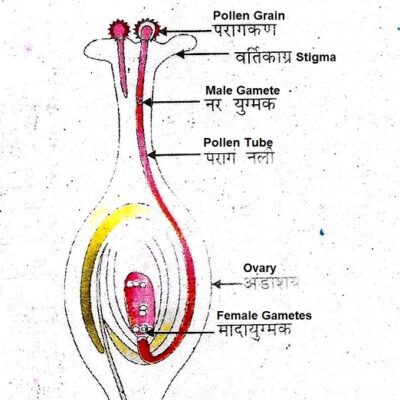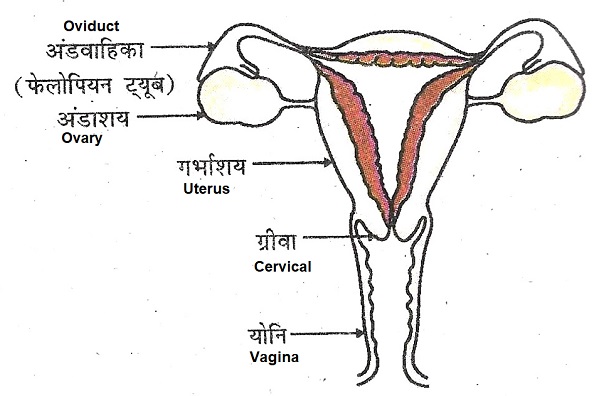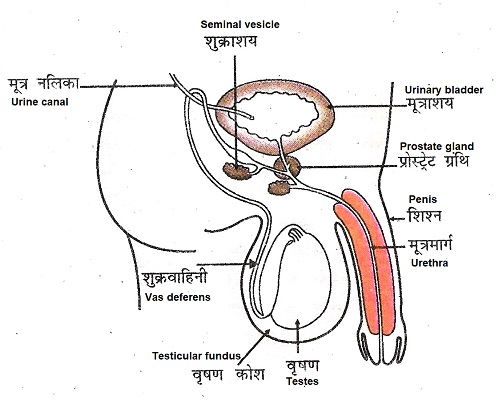प्रश्न 1. पुष्प में निषेचन क्रिया को प्रदर्शित करते हुए स्त्रीकेसर की लम्ब काट का नामांकित चित्र बनाइए एवं वर्णन कीजिए।
Draw and describe a labeled diagram of a longitudinal section of a pistil showing the process of fertilization in a flower.
(अथवा) आवृतबीजी (एन्जिओस्पर्म) पुष्प के स्त्रीकेसर के अनुदैर्ध्य काट का एक नामांकित चित्र बनाइए ।
(OR) Make a labeled diagram of the longitudinal section of the pistil of angiosperm flower.
उत्तर-पुष्पी पादपों के पुष्प में द्वि-निषेचन होता है। परागकणों के अंकुरण के फलस्वरूप बनी पराग नलिका वृद्धि करके वर्तिकाग्र और वर्तिका से होती हुई बीजाण्ड में प्रवेश करती है। पराग नलिका बीजाण्ड में बीजाण्ड द्वार से; निभाग छोर से अथवा अध्यावरण से बीजाण्ड के बाजीण्डकाय में पहुँचकर फट जाती है और दोनों नर युग्मकों को मुक्त कर देती है ।
एक नर युग्मक अण्डकोशिका से संयोजित होकर निषिक्ताण्ड बनाती है। यह वृद्धि तथा विभाजन द्वारा भ्रूण का निर्माण करता है, इसे वास्तविक निषेचन या संयुग्मन कहते हैं। दूसरा नर युग्मक द्वितीयक केन्द्रक (2x) से मिलकर प्राथमिक भ्रूणपोष केन्द्रक (3x) बनाता है, इसे त्रिसंलयन कहते हैं। इससे भ्रूणपोष बनाता है। संयुग्मन तथा त्रिसंलयन को सम्मिलित रूप से द्विनिषेचन कहते हैं।

Double fertilization occurs in the flowers of flowering plants. The pollen tube formed as a result of germination of pollen grains grows and enters the ovule through the stigma and stigma. Pollen tube into the ovule from the nucellus; After reaching the ovule from the end or from the integument, the segment bursts and releases both the male gametes.
A male gamete combines with the egg cell to form a nucellus. It forms an embryo by growth and division, this is called true fertilization or conjugation. The second male gamete combines with the secondary nucleus (2x) to form the primary endosperm nucleus (3x), this is called triple fusion. It forms endosperm. Conjugation and triple fusion are collectively called double fertilization.
प्रश्न 2. प्रजनन क्या है? नामांकित चित्र की सहायता से मादा मानव जनन तन्त्र का वर्णन कीजिए।
What is reproduction? Describe the female human reproductive system with the help of a labelled diagram.
(अथवा) मनुष्य की मादा जनन तन्त्र की संरचना तथा कार्य लिखिए।
(or) Write the structure and function of the human female reproductive system.
(अथवा) मानव के मानव जनन तन्त्र का सचित्र वर्णन कीजिए।
(or) Describe the human reproductive system with a diagram.
उत्तर – प्रजनन – यह जीवधारियों का विशिष्ट लक्षण है। प्रजनन द्वारा जीवधारी की सन्तति पीढ़ी-दर-पीढ़ी चलती रहती है। मनुष्य एकलिंगी होता है। इसमें नर तथा मादा जननांग अलग-अलग होते हैं। स्त्री और पुरुष को द्वितीयक लैंगिक लक्षणों के आधार पर पहचाना जा सकता है।
Reproduction – This is a special characteristic of living beings. Through reproduction, the progeny of living beings continues from generation to generation. Humans are unisexual. In this, male and female genitals are different. Men and women can be identified on the basis of secondary sexual characteristics.

मादा जनन अंग – स्त्री में निम्न जनन अंग पाये जाते हैं-
(i) अण्डाशय – एक जोड़ी अण्डाशय उदरगुहा में स्थित होते हैं। ये अण्डाकार, ठोस रचनायें होती हैं। अण्डाशय में अण्ड पुटिकाओं का निर्माण अण्डजन कोशिकाओं से होता है। परिपक्व अण्ड पुटिका अण्डाशय की सतह पर पहुँचकर फट जाती है और अण्डाणु को मुक्त कर देती है।
(ii) मुखिका – अण्डाशय से सटी कीपनुमा, झालरदार तथा रोमाभि संरचना होती है। इसे मुखिका या फिम्ब्रियेटेड कीप भी कहते हैं।
(iii) अण्डवाहिनी – मुखिका एक छोटी, कुण्डलित अण्डवाहिनी में खुलती है। इसका प्रारम्भिक भाग संकरा तथा रोमाभि होता है, इसे फैलोपियन नलिका कहते हैं। फैलोपियन नलिकायें पीछे की ओर एक चौड़े, पेशीय, ग्रन्थिल, रोमाभविहीन गर्भाशय में खुलती हैं। गर्भाशय में भ्रूण का विकास होता है।
(iv) योनि – गर्भाशय का पश्च भाग योनि कहलाता है। योनि के अधर तल पर स्थित मूत्राशय एक छोटे मूत्रमार्ग द्वारा योनि के पश्च भाग में खुलता है, इसे मूत्रजनन वेश्म कहते हैं। यह मादा जनन छिद्र या भग द्वारा शरीर से बाहर खुलता है।
(v) क्लाइटोरिस – भग के अग्रछोर पर एक छोटी-सी पेशीय रचना क्लाइटोरिस होती है।
(vi) सहायक जनन ग्रन्थियाँ -मादा जननांगों से सम्बन्धित बार्थोलिन ग्रन्थियाँ, रेक्टल ग्रन्थियाँ तथा पेरीनियल ग्रन्थियाँ होती हैं। ये जनन में सहायता करती हैं।
Female reproductive organs – The following reproductive organs are found in a female:
(i) Ovaries – A pair of ovaries are located in the abdominal cavity. These are oval, solid structures. Egg follicles are formed in the ovary from oogenic cells. The mature egg vesicle reaches the surface of the ovary and bursts, releasing the egg.
(ii) Mouth: It is a funnel-shaped, fringed and hairy structure adjacent to the ovary. It is also called mouthpiece or fimbriated funnel.
(iii) Oviduct – The mouth opens into a short, coiled oviduct. Its initial part is narrow and hairy, it is called fallopian tube. The fallopian tubes open posteriorly into a broad, muscular, glandular, hairless uterus. The embryo develops in the uterus.
(iv) Vagina – The posterior part of the uterus is called the vagina. The urinary bladder situated on the ventral surface of the vagina opens into the posterior part of the vagina through a short urethra, this is called the urogenital pore. This opens out of the body through the female genital pore or vulva.
(v) Clitoris – A small organ at the anterior end of the vulva. This muscular structure is the clitoris.
(vi) Accessory reproductive glands – Bartholin glands, rectal glands and perineal glands are associated with the female reproductive organs. These help in reproduction.
प्रश्न 3. नामांकित चित्र की सहायता से मनुष्य के नर जनन तन्त्र का वर्णन कीजिए।
Describe the human male reproductive system with the help of a labelled diagram.
(अथवा) मानव के नर जनन तन्त्र का सचित्र वर्णन कीजिए।
(Or) Describe the human male reproductive system with a diagram.
उत्तर – नर जनन अंग – मनुष्य एकलिंगी एवं जरायुज होता है। पुरुष में निम्न जननांग पाये जाते हैं-
(i) वृषण – एक जोड़ी वृषण उदरगुहा से बाहर थैली सदृश्य वृषण कोषों में स्थित होते हैं। वृषण का निर्माण शुक्रजनन नलिकाओं से मूत्र नलिका- होता है। शुक्रजनन नलिकाओं में शुक्रजनन द्वारा शुक्राणुओं का निर्माण होता है। वृषण से एक संकरी, चपटी संरचना चिपकी होती है, इसे एपीडिडाइमिस कहते हैं । एपीडिडाइमिस के पश्च भाग से शुक्रवाहिनी निकलती है।
स्तनी प्राणियों में वृषण शरीर के बाहर वृषण कोष में पाये जाते हैं, क्योंकि उच्च ताप के कारण शरीर के भीतर वृषण में शुक्राणुओं का निर्माण नहीं हो पाता है।
(ii) शुक्रवाहिनी – शुक्रवाहिनी वृक्षण नाल से उदरगुहा में पहुँचकर मूत्रवाहिनी के साथ फन्दा बनाती हुई थैली सदृश्य रचना शुक्राशय में खुल जाती है।
(iii) शुक्राशय – थैली सदृश्य शुक्राशय मूत्राशय के आधार भाग से लगा होता है, यह एक ग्रन्थिल रचना होती है। इसमें क्षारीय तरल स्रावित होता है जो शुक्राणुओं को सक्रिय रखता है। शुक्राणु सहित यह तरल ‘वीर्य’ कहलाता है।
(iv) मूत्रमार्ग – शुक्राशय एक संकरी स्खलन नलिका द्वारा मूत्रमार्ग में खुलता है। मूत्रमार्ग मैथुन अंग शिश्न से होता हुआ इसके शिखर पर स्थित मूत्रजनन छिद्र द्वारा बाहर खुलता है।
(v) शिश्न – यह मांसल बाह्य जननांग है। शिश्न शुक्राणुओं को मादा की योनि में पहुँचाता है; इससे शुक्राणु सुगमतापूर्वक मादा के गर्भाशय में पहुँच जाते हैं।
(vi) सहायक जनन ग्रन्थियाँ -नर जननांगों से सम्बन्धित या इनके निकट स्थित ग्रन्थियाँ होती हैं, जैसे- (अ) प्रोस्टेट ग्रन्थियाँ, (ब) काउपर्स ग्रन्थियाँ, (स) पेरीनियल ग्रन्थियाँ, तथा (द) रेक्टल ग्रन्थियाँ । ये जनन में सहायता करती हैं।
सहायक ग्रन्थियों के स्राव तथा शुक्राणुओं के मिलने से वीर्य बनता है। यह शुक्राणुओं को स्त्री की योनि में पहुँचाने के लिए एक तरल माध्यम का कार्य करता है। यह शुक्राणुओं का पोषण करता है और इन्हें सक्रिय रखता है। मैथुन के समय स्त्री के जनन मार्ग को चिकना बनाकर घर्षण को कम करता है।

Male reproductive organs – Humans are unisexual and viviparous. The following reproductive organs are found in males-
(i) Testes – A pair of testes are located in sac-like scrotum outside the abdominal cavity. Testes are formed from the spermatogenic tubes and the urethra. Spermatozoa are produced in the spermatogenic tubes by spermatogenesis. A narrow, flat structure is attached to the testes, it is called epididymis. The vas deferens emerges from the posterior part of the epididymis.
In mammals, testes are found in the scrotum outside the body, because due to high temperature, sperms are not produced in the testes inside the body.
(ii) Vas deferens – The vas deferens reaches the abdominal cavity from the spermatic canal and forms a loop with the ureter and opens in the sac-like structure called the seminal vesicle.
(iii) Seminal vesicle – The sac-like seminal vesicle is attached to the base of the urinary bladder, it is a glandular structure. An alkaline fluid is secreted in it which keeps the sperms active. This fluid along with the sperms is called ‘semen’.
(iv) Urethra – The seminal vesicle opens into the urethra through a narrow ejaculation duct. The urethra passes through the coital organ penis and opens out through the urogenital pore situated at its top.
(v) Penis – This is a fleshy external genital. The penis transports the sperms to the vagina of the female; due to this the sperms easily reach the uterus of the female.
(vi) Accessory reproductive glands – There are glands related to the male genitals or situated near them, such as – (a) prostate glands, (b) Cowper’s glands, (c) perineal glands, and (d) rectal glands. These help in reproduction.
Semen is formed by the mixing of the secretions of the accessory glands and the sperms. It acts as a liquid medium to transport the sperms to the vagina of the woman. It nourishes the sperms and keeps them active. It reduces friction by making the female’s reproductive tract smooth during intercourse.




